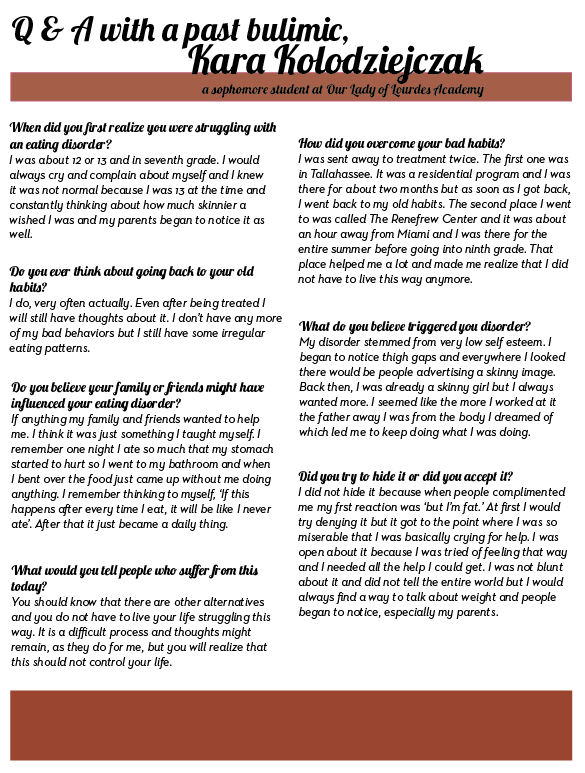A viscous habit that can be broken
November 12, 2014
The person sitting next to me just opened a pack of Doritos and it smells so amazing my stomach will not stop grumbling. I ignore it; I pretend I do not smell a thing. Food does not matter. I had too big of a dinner last night anyway and I did not go to the gym. I am so hungry though, I guess I could eat now and just go to the bathroom soon after. It will seem like I never even ate, right? Or, I could wait until I get home to eat so in addition to my purge, I can use one of my mom’s laxatives. These are the thoughts that swirl inside someone’s mind who struggles with bulimia nervosa, and you would not even know it.
Many people turn to food when they are bored, lonely or stressed. The same is true for people struggling with bulimia nervosa. The dictionary defines it as a disorder involving distortion of body image and an obsessive desire to lose weight, in which bouts of extreme overeating are followed by self-induced fasting, or purging- physically eliminating food from the body by vomiting or using a laxative, enema, or diuretics.
However, the dictionary has a limited definition of the disorder. The obsessive need to lose weight if paired with a wave of emotion. According to timberlineknolls.com, men and women with bulimia nervosa develop serious mental and emotional distortions. A person with bulimia may feel trapped in between wanting to eating and staying skinny. Those struggling with this disorder have the tendency to feel as if they live in a world of secrecy and shame where every thought centers around food and their image.
The disease, despite popular misconceptions, is far different from anorexia nervosa. Bulimics tend to binge eat only to later rid their bodies of the calories whereas anorexics have a desire to lose weight which leads them to stop binge eating.
Bulimia nervosa has two categories: purging bulimia and nonpurging bulimia. Those struggling with purging bulimia self-induce vomiting or misuse laxatives, diuretics or enemas after binging; however, those suffering from nonpurging bulimia may use different methods to rid themselves of the calories and prevent weight gain. For example, a bulimic may binge eat a burrito bowl from Chipotle when out with friends. A purging bulimic would sneak off into the bathroom only to purge while a nonpurging bulimic would spend four hours at the gym in attempt to burn off the calories.
This disorder affects men and women of all ages. According to the National Association of Anorexia Nervosa and Associated Eating Disorders (ANAD), roughly 24 million people of all genders and ages suffer from an eating disorder. About one to three percent of Americans (three to nine million people) are adolescents suffering with bulimia.
“I see that the majority of bulimics are girls and I think that is due to the fact that there is a lot of social pressure between adolescent females,” sophomore Daniel Domenech said. “The more self-conscious someone is, the more likely they are to diet and the stricter the diet the more obsessed one becomes with their weight which leads to the eating disorder.”
According to helpguide.org, when humans starve themselves, their bodies respond with powerful cravings to combat the lack of nutrition. Confirmed by mayoclinic.org, purging does not prevent weight gain because vomiting immediately after eating only eliminates 50 percent of the calories consumed, while laxatives only rid approximately 10 percent of calories consumed.
“People try so hard to get this perfect image because now a days they are being judged on their appearance,” freshman Emma Kettler said. “It really should not be about whether you are skinny or pretty enough. You should accept it based on your personality, not image.”
As stated by helpguide.org, advertisements and the diffusion of social media impact the perception of the “ideal body image.” Girls face the expectation of having toned bodies with curves, thigh gaps, and ab outlines while society pressures guys to have rock solid abs and bulging biceps.
Common symptoms of Bulimia Nervosa include: abdominal pain, chronic sore throat, broken blood vessels in the eyes, weakness, dizziness, tooth decay, mouth sores and a ruptured esophagus. According to ANAD, the most dangerous and common side effect is dehydration. Furthermore, overuse of laxatives and vomiting causes electrolyte imbalance in the body and leads to irregular heartbeat, kidney failure, and even death.
The National Eating Disorders Association (NEDA) has a toll free helpline at 1-800-931-2237 and an online chat that offers support for people struggling with eating disorders at nationaleatingdisorders.org. The hotline is open Mondays-Thursdays from 9:00 am-9:00 pm and Friday from 9:00 am-5:00 pm (EST).
Eating disorder treatment clinics like the Canopy Cove Eating Disorder Treatment Center in Tallahassee, FL and the Renfrew Center of Florida in Coconut Creek, FL also offer professional help to those who seek it.
“People struggling with this disorder may think that telling a friend or family member about it will change their view on them but that is not the case,” sophomore Gabriela Riveros said. “They have to know that someone who actually cares about them would do anything in their power to help because it is painful to see someone you love harm themselves.”











